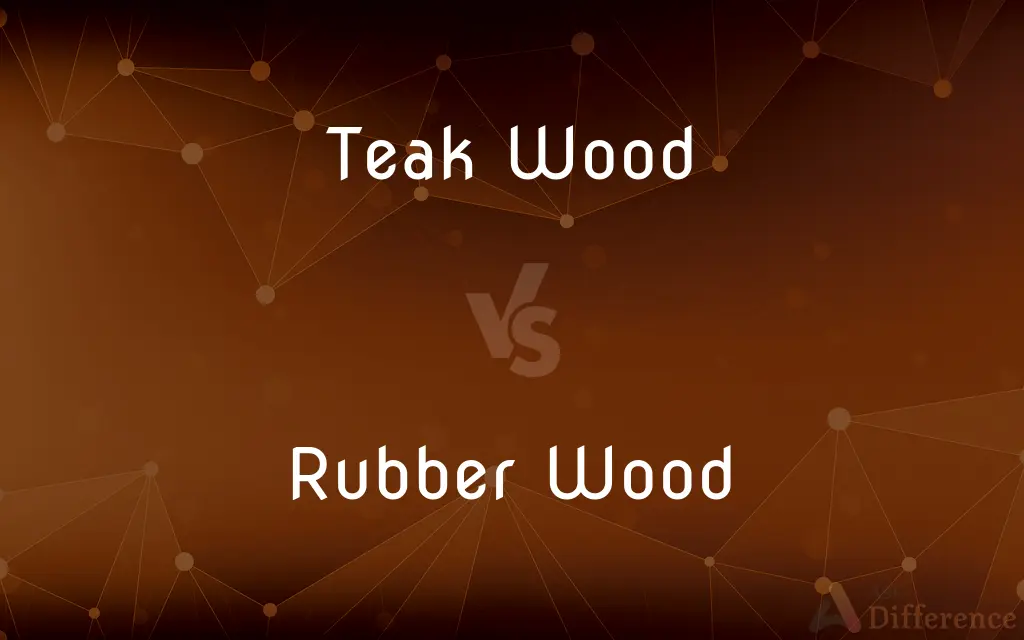Teak Wood vs. Rubber Wood — What's the Difference?
By Tayyaba Rehman — Published on November 10, 2023
Teak Wood: durable, high oil content, used in luxury items. Rubber Wood: eco-friendly, less durable, used in budget-friendly furniture.

Difference Between Teak Wood and Rubber Wood
Table of Contents
ADVERTISEMENT
Key Differences
Teak Wood is renowned for its impressive durability and water resistance, making it a preferred choice for high-quality furniture and outdoor applications. Rubber Wood, in contrast, is appreciated for its eco-friendly nature, typically sourced from used rubber trees, but it doesn't share the same resilience or water resistance as teak.
Teak Wood is often used in luxurious projects and high-end furniture due to its smooth finish, attractive grain, and resistance to decay, factors that justify its higher price. Rubber Wood is more commonly used in affordable furniture and is recognized for its contribution to sustainability, being harvested after the tree’s latex-producing cycle ends.
Teak Wood requires little maintenance due to its natural oils, which protect it from termites and other pests, a feature not inherent in many other woods. Rubber Wood, however, often requires treatment against pests and humidity because it lacks natural oils, contributing to its more extensive maintenance needs.
Teak Wood is often sourced from South and Southeast Asia, its availability contributing to its premium status and cost. Rubber Wood, on the other hand, is more widely available due to its status as a byproduct of rubber production, contributing to its affordability.
Teak Wood possesses a rich color palette, ranging from golden to medium brown, often featuring a unique grain pattern, adding to its aesthetic appeal. Rubber Wood is generally pale in color and less distinctive in appearance, but it takes to staining well, offering versatility in different furniture designs.
ADVERTISEMENT
Comparison Chart
Durability
High; resistant to decay
Lower; prone to humidity damage
Usage
Luxury furniture, boats, outdoors
Affordable furniture, indoors
Maintenance
Low; natural oils
Higher; lacks protective oils
Cost
Expensive
Economical
Environmental Impact
Moderate; slow growth
Low; uses post-latex-production
Compare with Definitions
Teak Wood
A hardwood known for its durability and water resistance.
The designer chose Teak Wood for the outdoor deck because of its longevity.
Rubber Wood
Prone to humidity damage, often used for indoor furniture.
They avoided using Rubber Wood for outdoor furniture due to its sensitivity to moisture.
Teak Wood
Wood characterized by its golden-brown color and high oil content.
The antique Teak Wood chest retained its luster even after decades.
Rubber Wood
A durable yet less expensive type of hardwood.
For their startup’s office furniture, they chose Rubber Wood for its affordability.
Teak Wood
Sourced primarily from tropical regions, known for slow growth and high demand.
The scarcity of genuine Teak Wood has led to the creation of sustainable plantations.
Rubber Wood
An eco-friendly wood used in manufacturing affordable furniture.
The Rubber Wood bed frame was both budget-friendly and sustainably sourced.
Teak Wood
A type of wood often used in high-end furniture or boat building.
The luxury yacht boasted handcrafted Teak Wood furnishings.
Rubber Wood
Harvested from rubber trees past their latex-producing prime.
After 30 years, the rubber trees were converted into Rubber Wood furniture.
Teak Wood
A prized material for both indoor and outdoor furniture due to its strength.
They invested in a Teak Wood dining set, knowing it would last a lifetime.
Rubber Wood
Known for its light color and ease of staining.
The Rubber Wood kitchen cabinets were stained to match the darker hardwood floors.
Common Curiosities
Why is Teak Wood more expensive than Rubber Wood?
Teak Wood is rarer, has superior durability and a distinctive appearance, making it more valuable.
What is Teak Wood known for?
Teak Wood is known for its durability, water resistance, and luxurious status in furniture and shipbuilding.
Can Rubber Wood be used outdoors?
Rubber Wood isn't ideal for outdoor use without extensive treatments, as it's susceptible to humidity and pests.
Does Teak Wood need a lot of maintenance?
No, Teak Wood requires minimal maintenance due to its natural oils and resistance to decay.
What are common uses for Rubber Wood?
Rubber Wood is commonly used in affordable furniture, cabinetry, and interior millwork.
Is Teak Wood good for outdoor furniture?
Yes, the natural oils in Teak Wood make it ideal for outdoor furniture due to its resistance to weather conditions.
Why is Rubber Wood considered eco-friendly?
Rubber Wood is eco-friendly because it's sourced from rubber trees no longer producing latex, reducing waste.
Does Rubber Wood warp easily?
Rubber Wood can warp if exposed to varying temperatures and humidity, so it's best used indoors.
How durable is Rubber Wood for furniture?
Rubber Wood has a decent strength and durability but doesn’t match the longevity of teak.
Where does Teak Wood come from?
Teak Wood primarily comes from tropical regions, notably Southeast Asia.
Is Rubber Wood susceptible to pest infestations?
Yes, Rubber Wood can be vulnerable to pests and requires treatment for protection.
Can Teak Wood be painted or stained?
Yes, but it's often left natural to showcase its color and grain. If desired, it requires proper surface preparation.
How should I care for Rubber Wood furniture?
Regular cleaning, avoiding prolonged moisture, and using wood protectant can help maintain Rubber Wood furniture.
How can I identify genuine Teak Wood?
Genuine Teak Wood has a golden-brown color, high oil content, and a distinct, straight grain pattern.
Are there sustainability concerns with Teak Wood?
Yes, due to overharvesting, it's best to seek Teak Wood from certified sustainable sources.
Share Your Discovery

Previous Comparison
Redmi 2 vs. Redmi 2 Prime
Next Comparison
French Braid vs. BraidAuthor Spotlight
Written by
Tayyaba RehmanTayyaba Rehman is a distinguished writer, currently serving as a primary contributor to askdifference.com. As a researcher in semantics and etymology, Tayyaba's passion for the complexity of languages and their distinctions has found a perfect home on the platform. Tayyaba delves into the intricacies of language, distinguishing between commonly confused words and phrases, thereby providing clarity for readers worldwide.













































